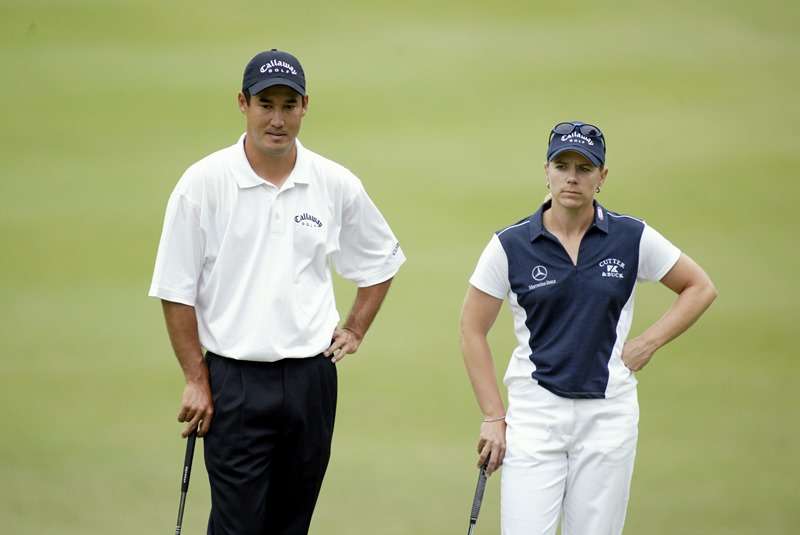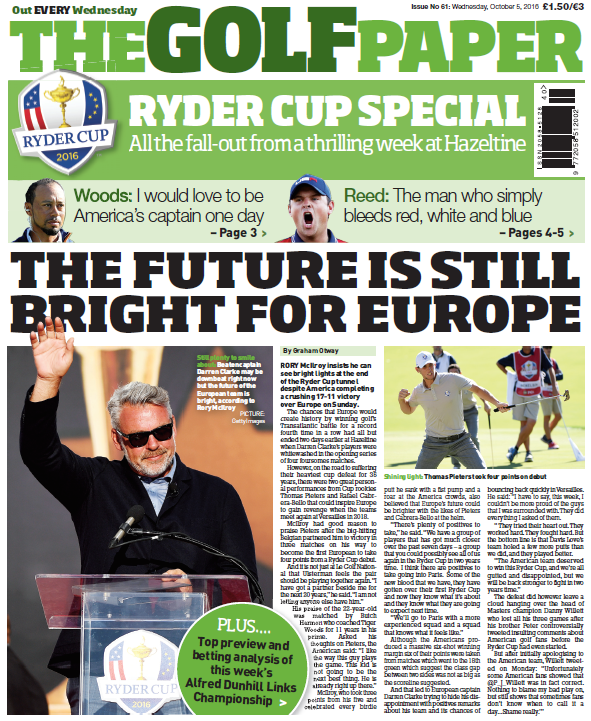Features
Huggan column: Europe’s first mixed event a MUST

No split: Annika Sorenstam, pictured with Dean Wilson at the PGA Tour’s 2003 Colonial in Texas (Photo by Getty Images)
by John Huggan
You may or may not have noticed, but for the last three years something different has been happening in Australia. Since 2013, the Victorian Open Championship has been the only event in the world where men and women compete simultaneously on the same courses – albeit playing from different and appropriate tees – for the same prize money. It is a format that has proven hugely successful with players and spectators. Strong fields on both sides of the gender divide annually entertain big crowds at the 13th Beach Golf Links.
The message is clear: golfers inside and outside the ropes are in the market for something a bit different from the norm we see on every tour just about every week of the year. Which makes this observer wonder why it hasn’t been copied elsewhere. The benefits are many, not least the opportunity the huge crowds have to compare and contrast the styles and methods of the professionals, both male and female. Indeed, one imagines that the average player of either gender will surely have learnt much from the ways in which the generally less powerful ladies plot their way round a golf course. The modern game at the highest level is not short of power, but there remains scope amid the crashing, banging and walloping for strategic nous and tactical acumen.
That has long been the case, as has the opportunity to attract attention in an increasingly competitive media world. Remember May 2003, when Annika Sorenstam, then the world’s best female player, was invited to play in the Colonial Invitational? Or the time, less than a year later, when
Laura Davies teed up in the ANZ Championship, an event co-sanctioned by the European and Australasian Tours? On both occasions huge publicity was generated, especially for a women’s game scrambling to fill many column inches.
“Years later, I still hear new stories surfacing from people who drove from everywhere to be a part of it, who say they were inspired by it,” said Sorenstam. “I hear from parents with daughters who say it really showed then that if they have a dream, they need to follow it. I think people connected with it because they could see themselves, that if they wanted to achieve something, they have to face their fears and take the opportunities that are there for them.”
Last week, the European Tour and the Ladies European Tour (LET) took a step towards emulating the Vic Open when both held events at the Royal Golf Dar Es Salaam resort in Morocco. Yes, the two were played separately on adjacent courses, but it was a sign that both circuits are open to further collaboration down the road.
The possibilities are many. We could, for example, soon enough be watching a Ryder/Solheim Cup match between mixed European and American sides. Certainly, European Tour chief Keith Pelley seems enthusiastic about a stronger relationship with the LET down the road. Speaking before last week’s events, he was almost bouncing up and down in his chair at the prospect.
“It’s terrific to be here alongside the LET to stage the men’s and women’s tournaments just three months prior to the Olympics,” said the colourful Canadian. “There are many Olympic hopefuls competing in both tournaments, so it’s a great opportunity to showcase the strength of the men’s and women’s games.
“It’s an innovative approach and we’re keen to see how it works this week before deciding on the next steps. We have a number of ambitious ideas we will be announcing in the coming months, but this week we’re focused on the start of a partnership we hope can grow over time.”
All of which sounds incredibly positive. And, it must be said, in complete contrast to the pedestrian approach that the International Golf Federation has taken with regard to the upcoming Olympics. Four rounds of tedious strokeplay are going to be bad enough. But there will also be no interaction between the sexes in Rio de Janeiro, the men’s and women’s events are to be played a week apart. Throw in the notion that some sort of team and mixed play could and should have been part of the mix and that’s an awful lot of point missing.
Think how much more appealing the Olympic golf event could have been if it had included some inventive formats that allowed the men and women to play together at least some of the time. For a sport too often seen as little more than an out-of-touch bastion of sexism and elitism, that would have been a wonderful thing to see.
To be fair, the United States Golf Association came close to an uncharacteristic moment of innovation two years ago when the US Open and the US Women’s Open were played at Pinehurst No 2 on consecutive weeks. Both were great successes and produced some great golf, especially from the eventual champions Martin Kaymer and Michelle Wie. But, at the same time, an inherent problem was highlighted. When it comes to men and women playing the same 18 holes, the length of the rough is nearly always going to be an issue.
It has nothing to do with superior or inferior technique, but it is a fact of life that the elite male golfers are simply more powerful than their female counterparts. So the growing of long grass alongside fairways is less of an obstacle in the men’s game than it is in the women’s. All of which made Pinehurst, a course with little or no rough, the ideal venue for both. Elsewhere though, a balancing act must be followed and the course has to be playable and challenging for both the ladies and the gents. No easy task.
Still, it is a prospect worth pursuing. Imagine European Tour and LET events at 36-hole complexes like Walton Heath, Sunningdale and The Berkshire. Or modifying the format of the Dunhill Links Championship to include men and women. Come on guys and gals, get to it.





